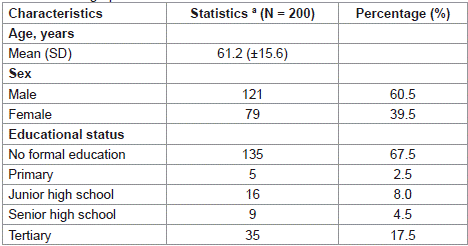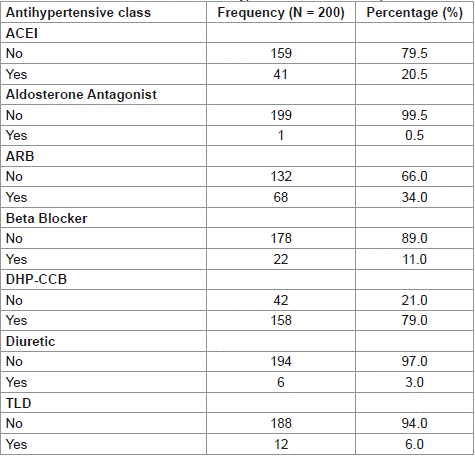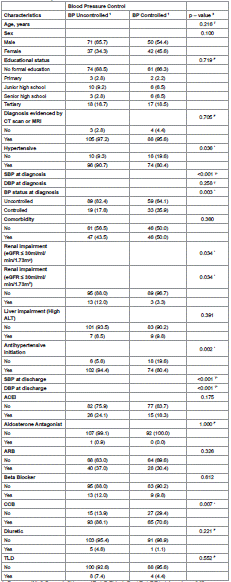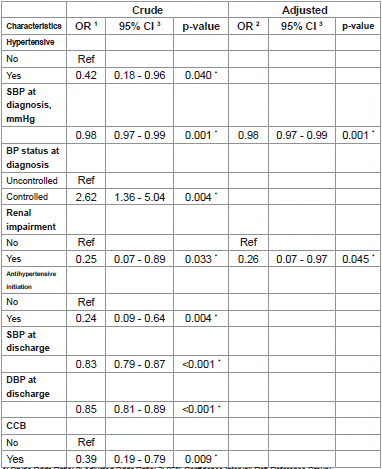
Research Article
Austin J Cerebrovasc Dis & Stroke. 2025; 11(1): 1094.
Antihypertensive Pharmacotherapy Usage Patterns for Secondary Prevention and Associated Blood Pressure Outcomes in Ischemic Stroke Survivors at the Tamale Teaching Hospital
Ghunney MK¹, Malick MMD²* and Akumanue C²
¹Directorate of Pharmacy, Tamale Teaching Hospital, Ghana
²Department of Pharmacy Practice, School of Pharmacy and Pharmaceutical Sciences, University for Development Studies, Ghana
*Corresponding author: Martin Mumuni Danaah Malick, Department of Pharmacy Practice, School of Pharmacy and Pharmaceutical Sciences, University for Development Studies, Ghana Email: mdanaah@uds.edu.gh
Received: July 17, 2025 Accepted: July 28, 2025 Published: July 31, 2025
Abstract
Background: The burden of ischemic stroke continues to increase across Sub-Saharan Africa, including Ghana. The use of pharmacological interventions for the secondary prevention of ischemic stroke, especially appropriate antihypertensive pharmacotherapy, is one of the most reliable and effective means of decreasing the recurrence of stroke. However, majority of these patients do not receive the recommended antihypertensive pharmacotherapies for secondary prevention, leading to prolonged recovery time with associated increased morbidity and mortality.
Aim: To assess the antihypertensive Pharmacotherapy usage patterns for Secondary prevention in ischemic stroke survivors and associated outcomes at the Tamale Teaching Hospital (TTH)
Methods: We reviewed the Hospital electronic database (LHIMS) of 200 Ischemic stroke survivors at the TTH from January 2022 to December 2023 who had documented evidence of Ischemic stroke diagnosis either through a CT scan or an MRI while those with a diagnosis of hemorrhagic stroke or Ischemic stroke with hemorrhagic transformation were excluded. Details on patient’s demographics, Classes of antihypertensive medications use patterns and Blood Pressure (BP) values at diagnosis, comorbid conditions, renal and hepatic functions, were extracted into an Excel sheet. The blood pressure control at discharge was categorized as either controlled or uncontrolled based on the 2021 AHA/ASA Guideline for the Prevention of Stroke in Patients with Stroke and Transient Ischemic Attack (BP goal of <130/80). The data was imported into Stata/SE Version 17.0 for cleaning and statistical analysis.
Results: Ischemic Stroke diagnosis based on CT scan or MRI: 193 (96.5%), No 7 (3.5%). Diagnosis of Hypertension: Yes 172 (86%), No 28 (14%). SBP at diagnosis, mmHg (Mean SD, 153 (±29); DBP at diagnosis, mmHg (Mean (SD), 93 (±19). BP status at diagnosis: Controlled 52 (26%), Uncontrolled 148 (74%). Initiation of Antihypertensive medication before discharge: Yes 176 (88%), No 24 (12%). Class of antihypertensive medications initiated: ACEI Yes 41(20.5%), No 159 (79.5%); ARBs: Yes 68 (34%), No 132 (665); Beta Blockers: Yes 22 (11%), No l78 (89%). NDP-CCB: Yes 158 (79%), No 42 (21%). Diuretics: Yes 6 (3%), No 194 (97%). Blood pressure control at discharge: Controlled 92 (46%), Uncontrolled 108 (54%). SBP at discharge, mmHg: Mean (SD) 128 (±16). DBP at discharge, mmHg: Mean (SD) 80 (±12).
Conclusions: Majority of Stroke Survivors at the TTH received antihypertensive Pharmacotherapy and the most prescribed were DHP-CCB, ACEIs and ARBs. Most of the patients had poorly controlled blood pressures at diagnosis and the major determinants were hypertension and renal impairment.
Keywords: Secondary Prevention; Ischemic Stroke; Survivors; Antihypertensive Pharmacotherapy
Introduction
Ischemic strokes can be caused by a myriad of factors, and identifying the cause is essential in effective management as well as secondary prevention [1]. Stroke remains the second leading cause of mortality and combined mortality and disability worldwide. In 2019, the global incidence of stroke was 12.2 million, and the prevalence was 101.5 million, with 77.2 million being ischemic strokes, 20.7 million being intracerebral hemorrhages, and 8.4 million being subarachnoid hemorrhages [2]. The burden of ischemic stroke and its associated mortalities is also significantly higher in developing countries compared to developed nations [3]. Survivors of ischemic strokes remain at an increased risk of various cardiovascular events including myocardial infarctions, recurrent strokes, as well as death from various vascular causes [4]. In Africa, stroke incidence keeps increasing with time, with high mortality rates recorded across several African countries. Stroke is known to account for about 40% of hypertension related complications in the University of Port Harcourt Teaching Hospital in Nigeria. In several West African countries, it is estimated to be the leading cause of adult neurological admissions, accounting for up to 65% of such hospital admissions [5]. Hypertension remains one of the most essential risk factors for the development and progression of ischemic stroke and High blood pressure may directly increase the risk of cardio embolism by having a direct activity on the heart [6]. The use of pharmacological interventions for the secondary prevention of ischemic stroke is one of the most reliable and effective means of decreasing the recurrence of stroke. This can be done using various interventions such as antiplatelet agents, lipid lowering drugs, antihypertensive agents in hypertensive patients, and anticoagulants in cardio embolic strokes [7]. In a meta-analysis including 8 trials and 33,774 patients diagnosed with either ischemic stroke or transient ischemic attack, the use of antihypertensive drugs was associated with a 1.9% risk reduction of stroke but does not affect the risk of all-cause mortality [8]. Blood pressure lowering with appropriate antihypertensive medications is crucial in preventing stroke recurrence and improving outcomes. It is recommended that patients who are stable neurologically with cerebrovascular disorders would benefit from a blood pressure goal of less than 130/80mmHg [9]. The effect of blood pressure lowering for secondary stroke prevention is consistent, irrespective of previous hypertension and most subtypes of stroke (10) . For stroke prevention, classes of antihypertensive that have shown significant benefits include thiazide diuretics, angiotensin converting enzyme inhibitors, and angiotensin receptor antagonist [9,11]. In spite of various evidence available in understanding stroke care in Africa, there still remain some gaps in therapeutic, as well as rehabilitative stroke services in the African continent [12].
Materials and Methods
We reviewed the Hospital electronic database (LHIMS) of 200 Ischemic stroke survivors at the TTH from January 2022 to December 2023 who had documented evidence of Ischemic stroke diagnosis either through a CT scan or an MRI while those with a diagnosis of hemorrhagic stroke or Ischemic stroke with hemorrhagic transformation were excluded. Details on patient’s demographics, Classes of antihypertensive medications use patterns and Blood Pressure (BP) values at diagnosis, comorbid conditions, renal and hepatic functions, were extracted into an Excel sheet. The blood pressure control at discharge was categorized as either controlled or uncontrolled based on the 2021 AHA/ASA Guideline for the Prevention of Stroke in Patients with Stroke and Transient Ischemic Attack (BP goal of <130/80). The data was imported into Stata/SE Version 17.0 for cleaning and statistical analysis. Continuous variables were assessed for normality using the Shapiro-Wilk test and visualized through Q-Q plots or histograms. Skewed continuous variables were summarized as medians with interquartile ranges (IQR), while normally distributed variables were reported as means with standard deviations (SD). Categorical variables were described using frequencies and percentages. The associations between independent variables including demographic characteristics, clinical factors, and classes of antihypertensive medications prescribed versus good blood pressure control were assessed using Pearson’s chi-squared test. Fisher’s exact test was employed when the expected frequencies in any group of a categorical variable were less than five to ensure statistical robustness. For normally distributed continuous variables, associations with good blood pressure control were evaluated using the t-test, while non-parametric continuous variables were analyzed using the Wilcoxon rank-sum test.
A binary logistic regression model was applied to identify factors associated with good blood pressure control, with odds ratios (OR) and 95% confidence intervals (CI) used to quantify these associations. Variables with p-values <0.05 in the tests of association analysis were included in a backward stepwise binary logistic regression to adjust for potential confounding factors and identify independent predictors of good blood pressure control. Variables with p-values <0.05 in the multivariable model were considered significant predictors of good blood pressure control.
Results
Ischemic Stroke diagnosis based on CT scan or MRI: 193 (96.5%), No 7 (3.5%). Diagnosis of Hypertension: Yes 172 (86%), No 28 (14%). SBP at diagnosis, mmHg (Mean SD, 153 (±29); DBP at diagnosis, mmHg (Mean (SD), 93 (±19). BP status at diagnosis: Controlled 52 (26%), Uncontrolled 148 (74%). Initiation of Antihypertensive medication before discharge: Yes 176 (88%), No 24 (12%). Class of antihypertensive medications initiated: ACEI Yes 41(20.5%), No 159 (79.5%); ARBs: Yes 68 (34%), No 132 (665); Beta Blockers: Yes 22 (11%), No l78 (89%). NDP-CCB: Yes 158 (79%), No 42 (21%). Diuretics: Yes 6 (3%), No 194 (97%). Blood pressure control at discharge: Controlled 92 (46%), Uncontrolled 108 (54%). SBP at discharge, mmHg: Mean (SD) 128 (±16). DBP at discharge, mmHg: Mean (SD) 80 (±12) (Table 1-5).
Discussion
Majority of the patients were females with a mean age of 63 years and no formal education (Table 1). Most of the patients were diagnosed with Ischemic Stroke via CT or MRI, had comorbidities and were hypertensive at diagnosis. (Table 2). This confirms what has been reported by Boehme et al, that hypertension is very common and can be termed as an independent risk factor for ischemic stroke [13]. In our study, hypertension was also the most common comorbid condition among ischemic stroke survivors. This is consistent with a study conducted by Kalkonde et al, which showed about 57% of participants were hypertensive [14]. Controlling risk factors, including hypertension, is one of the crucial strategies for preventing secondary ischemic stroke [15]. Certain antihypertensive classes have been extensively studied in stroke patients for their ability to effectively manage elevated blood pressures and also reduce stroke recurrence in various jurisdiction. In our study, the classes of antihypertensive agents that possess enormous evidence with respect to their secondary prevention benefits were under prescribed, with 20.5% receiving ACEIs, then 34% received ARBs and a combined 9% received thiazide and thiazide-like diuretics (Table 3). According to Khan et al, the most commonly prescribed antihypertensive medication during their study was dihydropyridine calcium channel blockers, just like in our study [16]. Even though dihydropyridine calcium channel blockers are recommended for the management of hypertension in stroke patients, evidence suggesting their efficacy in secondary stroke prevention is limited. Nevertheless, the use of dihydropyridine calcium channel blockers is reasonable for stroke patients who may require additional antihypertensive medication [11]. The target BP for ischemic stroke is considered to be <130/80mmHg, and so the average SBP and DBP obtained from our study (Table 2) can be considered suboptimal [11]. Slightly over half of hypertensive patients were also noted to have uncontrolled blood pressure despite being prescribed antihypertensive, the reasons for this are multifactorial and beyond the scope of our study (Table 3). This is consistent with a study by Olson et al which also confirmed that uncontrolled blood pressure is one of the most common phenomena in stroke patients. Olson and Colleagues reported that close to 57% of participants had uncontrolled BP despite initiation of antihypertensive agents [17].

Table 1: Demographic characteristics of ischemic stroke survivors.

Table 2: Clinical characteristics of ischemic stroke survivors.

Table 3: Distribution of the class of antihypertensive medication prescribed.
The bivariate analysis showed that for each unit increase in SBP at diagnosis, the odds of achieving good BP control decreases by 2% (Crude OR = 0.98; 95% CI: 0.97 - 0.99; p-value = 0.001). This observation was still true even after adjusting for cofounders (Adjusted OR = 0.98; 95% CI: 0.97 - 0.99; p-value = 0.001) (Table 4). These observations may be attributed to parameters that were probably not considered in our study. Another determinant observed during our study is renal impairment. Patients who presented with renal impairment had a significantly lower odds of achieving good blood pressure control compared to participants with no renal impairment (Crude OR = 0.25; 95% CI: 0.07 - 0.89; p-value = 0.033) (Table 5). Furthermore, initiation of BP medications has shown to be associated with lower odds of achieving blood pressure control, probably due to the lack of control by a large portion of the participants of this study.

Table 4: Association test between patients' demographic, clinical characteristics
and class of antihypertensive medication prescribed versus blood pressure
control at discharge.

Table 5: Logistic regression for the determinants of good blood pressure
control.
Limitations of the Study
The biggest limitation of our study is that we could not establish a possible causal relationship between the adherence to the dosage regimens of the prescribed antihypertensive medications and adequacy of blood pressure control. Also, the retrospective nature of our study design did not create a good opportunity for us analyse the impact of adequate blood pressure on the rate and severity of recurrent Ischemic strokes.
Conclusions
The pattern of prescribing antihypertensive medications with the highest secondary prevention potential in ischemic stroke survivors at the Tamale Teaching Hospital is substandard resulting in suboptimal blood pressure controls. The most commonly prescribed class of antihypertensive medications for ischemic stroke survivors at the Tamale Teaching Hospital were dihydropyridine calcium channel blockers, ACEIs and ARBs. The major determinants of poor blood pressure control at diagnosis were hypertension and renal impairment.
Recommendations
• Clinicians should be sensitized on the trends observed in this study, and also the need to ensure adherence to relevant clinical guidelines.
• Further research should be conducted to assess the specific prescribe-related or patient-related factors that contribute to the inability for patients to receive their pharmacological secondary prevention.
• The hospital may need to consider employing the services of more neurologists, as well as clinical pharmacists in order to improve the level of pharmaceutical care of the patients.
• The hospital should also expand the stroke unit and equip it with the requisite resources in order to ensure that stroke patients are well monitored and well taken care of.
Authors Contributions
MG conceived the research idea and collected all the relevant data including the literature review under the supervision of MMDM. MMDM wrote the manuscript with the help of CA who also performed the data analysis. All the authors thoroughly reviewed the manuscript and approved its content for publication
Acknowledgement
All the researchers wish to officially acknowledge and appreciate the enormous aupport and valuable inputs received from all members of the Tamale Teaching Hospital Health Information Management Department.
Data Availability Statement
All the quantitative and qualitative data used in writing the article are included in this manuscript.
References
- Adams HP, Bendixen BH, Kappelle LJ, Biller J, Love BB, Gordon DL & Marsh EE. Classification of subtype of acute ischemic stroke. Definitions for use in a multicenter clinical trial. TOAST. Trial of Org 10172 in Acute Stroke Treatment. Stroke. 1993; 24: 35–41.
- Virani SS, Alonso A, Aparicio HJ, Benjamin EJ, Bittencourt MS, Callaway CW, On behalf of the American Heart Association Council on Epidemiology and Prevention Statistics Committee and Stroke Statistics Subcommittee, et al Heart Disease and Stroke Statistics—2021 Update: A Report from the American Heart Association. Circulation. 2021b; 143.
- Fan J, Li X, Yu X, Liu Z, Jiang Y, Fang Y, et al. Global Burden, Risk Factor Analysis, and Prediction Study of Ischemic Stroke, 1990–2030. Neurology. 2023; 101: e137–e150.
- Hackam DG & Spence JD. Combining multiple approaches for the secondary prevention of vascular events after stroke: A quantitative modeling study. Stroke. 2007; 38: 1881–1885.
- Owolabi MO, Arulogun O, Melikam S, Adeoye AM, Akarolo-Anthony S, Akinyemi R, et al. The burden of stroke in Africa: A glance at the present and a glimpse into the future. Cardiovascular Journal of Africa. 2015; 26: S27–S38.
- Verdecchia P, Angeli F & Reboldi G. Hypertension and Atrial Fibrillation: Doubts and Certainties From Basic and Clinical Studies. Circulation Research. 2018; 122: 352–368.
- Ford B. Secondary Prevention of Ischemic Stroke: Updated Guidelines From AHA/ASA. 2022; 105.
- Boncoraglio GB, Del Giovane C & Tramacere I. Antihypertensive Drugs for Secondary Prevention after Ischemic Stroke or Transient Ischemic Attack: A Systematic Review and Meta-Analysis. Stroke. 2021; 52: 1974–1982.
- Kleindorfer DO, Towfighi A, Chaturvedi S, Cockroft KM, Gutierrez J, Lombardi- Hill D, et al. 2021 Guideline for the Prevention of Stroke in Patients With Stroke and Transient Ischemic Attack: A Guideline From the American Heart Association/American Stroke Association. Stroke. 2021; 52.
- Diener H-C & Hankey GJ. Primary and Secondary Prevention of Ischemic Stroke and Cerebral Hemorrhage: JACC Focus Seminar. Journal of the American College of Cardiology. 2020; 75: 1804–1818.
- Kleindorfer DO, Towfighi A, Chaturvedi S, Cockroft KM, Gutierrez J, Lombardi- Hill D, et al. 2021 Guideline for the Prevention of Stroke in Patients With Stroke and Transient Ischemic Attack: A Guideline From the American Heart Association/American Stroke Association. Stroke. 2021; 52.
- Akinyemi RO, Ovbiagele B, Adeniji OA, Sarfo FS, Abd-Allah F, Adoukonou T, et al. Stroke in Africa: Profile, progress, prospects and priorities. Nature Reviews Neurology. 2021; 17: 10.
- Boehme AK, Esenwa C & Elkind MSV. Stroke Risk Factors, Genetics, and Prevention. Circulation Research. 2017; 120: 472–495.
- Kalkonde Y, Jadhao S, Deshmukh M, Sen Gupta S & Bang A. Gaps in secondary prevention among stroke survivors in rural Gadchiroli, India: A community-based cross-sectional study. Wellcome Open Research. 2020; 5: 263.
- Choudhury MJH, Chowdhury MTI, Nayeem A & Jahan WA. Modifiable and Non-Modifiable Risk Factors of Stroke: A Review Update. Journal of National Institute of Neurosciences Bangladesh. 2015; 1: 22–26.
- Khan NA, Yun L, Humphries K & Kapral M. Antihypertensive Drug Use and Adherence After Stroke: Are There Sex Differences? Stroke. 2010; 41: 1445– 1449.
- Olson KL, Lash LJ, Delate T, Wood M, Rasmussen J, Denham AM & Merenich JA. Ambulatory Treatment Gaps in Patients with Ischemic Stroke or Transient Ischemic Attack. The Permanente Journal. 2013; 17: 28–34.